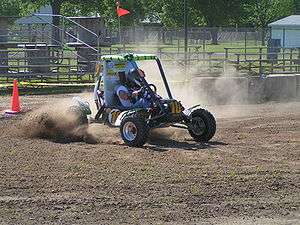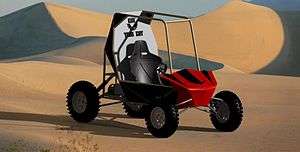Baja SAE
Baja SAE is an intercollegiate design competition run by the Society of Automotive Engineers (SAE). Teams of students from universities all over the world design and build small off-road cars. The cars all have engines of the same specifications. As of 2014 the engine has been an unmodified Briggs & Stratton Intek 20 single-cylinder with a displacement of 305cc and power output of approximately 10 bhp (7.5 kW).
The goal in Baja SAE racing is to design, build and race off-road vehicles that can withstand the harshest elements of rough terrain. The vehicles used in Baja SAE racing are often similar in appearance to dune buggies. Before 2007, the events were called "Mini Baja."


Each year as many as 141 Baja cars are entered in the Baja SAE events across the US and around the world where events are held including India, China, Brazil, South Africa and Korea. In India, this event is run by SAE India. In China, this event is run by SAE China starting in 2015. All cars must adhere to SAE's rules, and pass SAE's technical inspection and judging; a car may not race until all safety inspections are passed. Small engine manufacturer Briggs & Stratton sponsors Baja SAE teams by providing the SAE sanctioned engine free of charge, at a replacement rate of one engine for every two years in competition.
There are multiple dynamic events, usually four per event, as well as a single four-hour endurance race. The dynamic events include hill climbs, chain pulls, maneuverability events, rock crawls, and suspension & traction events. Previously the cars had to be able to float and propel itself on water under its own power. This was changed from 2012 competition onward due to safety concerns.
Static events, such as written reports, presentations and design evaluations are provided by participating teams. This is when the teams are judged on ergonomics, functionality, and producibility of their cars; ensuring that the final placement of the team does not rest solely on the vehicle's performance but rather on a combination of static and dynamic events. Required reports detail the engineering and design process that was used in developing each system of the team’s vehicle, supported with sound engineering principles.
Also, a cost report that provides all the background information necessary to verify the vehicle’s actual cost is used to rate the most economically feasible for production. These reports are submitted weeks in advance of each event, where the presentations and design evaluations are given on site in the presence of SAE design judges.

Origins
The Baja SAE Competition originated at the University of South Carolina in 1976, under the supervision of Dr. J. F. Stevens. Only 10 teams took part in the very first race. Since that time, the competition has grown to become a premier engineering design series with over 100 university teams participating in each race.
Objectives
Baja SAE is an intercollegiate engineering design competition for undergraduate and graduate engineering students. The object of the competition is to simulate real-world engineering design projects and their related challenges. Each team is competing to have its design accepted for manufacture by a fictitious firm. The students must function as a team to design, build, test, promote and compete a vehicle within the limits of the rules, also to generate financial support for their project and manage their educational priorities.
Each team's goal is to design and build a prototype of a rugged, single seat, off-road recreational vehicle intended for sale to the non-professional weekend off-road enthusiast. The vehicle must be safe, easily transported, easily maintained and fun to drive. It should be able to negotiate rough terrain without damage. As of 2010, the SAE Baja Series consisted of three competitions, though in the past there have been as many as seven sanctioned events. A Baja SAE competition event consists of three to four days.
Static Events
The static events are usually held on the first two days of competition. Static events consist of: Technical Inspection, Cost, Design Judging, and Sales Presentation.
Technical Inspection
All vehicles competing in the race must pass through Tech Inspection. The vehicles are checked by inspectors to make sure that teams adhere to the rules and safety standards set by SAE. New for the 2015 season is a required frame pre-check. All teams must submit frame documentation and frame drawings to be approved by SAE prior to the races.[1]
Cost Event
Teams submit a cost report before races. The cost report may consist of a maximum of three sections: Overview (optional), Costing Sheets, and Cost Documentation. The optional overview "is intended to give each team the opportunity to point out, and briefly comment on, any design features or fabrication processes that are innovative or are expected to result in significant cost savings. Teams may also use the overview to explain items or processes that might appear to be discrepancies within the report."[1] "The core of the report is the series of costing sheets. This section must contain the one-page summary sheet broken up into the individual subsystems." [1] The Cost Documentation "includes copies of receipts, invoices, price tags, catalog pages, online prices, or other documentation, to substantiate the costs of the parts and materials of any item costing more than $30. Cost documentation must be at full retail US prices. The use of foreign receipts, purchases from discount sites such as Craigslist, EBay or junk yards are not allowed. Starting in 2016, transponders are no longer part of the cost report and therefore no documentation for them is needed either.[2] The report is expected to be comprehensive, well documented, truthful and accurate."[1] At the race, the ten teams with lowest cost in their cost report are then audited by an official. The official will go in depth to review the cost documents and compare them to the actual vehicle. Missing items or math errors will be added to the cost document and a penalty may be issued.
Design Judging
Design Judging is when teams have the opportunity to defend/explain the reasoning used behind designing their vehicle. Prior to the race weekend, a Design Report is submitted. This report is reviewed by the judges who will be judging the vehicle during the event. Taken from the SAE rules, "Students will be judged on the creation of design specifications and the ability to meet those specifications, computer aided drafting, analysis, testing and development, manufacturability, serviceability, system integration and how the vehicle works together as a whole...The vehicle that illustrates the best use of engineering to meet the design goals and the best understanding of the design by the team members will win the design event."[1]
Sales Presentation
Since the 2014 season, the sales presentation has been a standard static event at every race. The entire premise behind the Baja SAE competition is to compete for a fictitious contract to manufacture 4000 units a year. The sales presentation is pitching to a panel of "executives" of a hypothetical manufacturing company to try and convince them to purchase the team's vehicle design. The presentation is limited to 10 minutes, with a 5-minute question period. "The presentation event will be scored based on such categories as
1. The content of the presentation
2. The organization of the presentation
3. The effectiveness of the visual aids
4. The speaker’s delivery, and
5. The team’s responses to the judge’s questions. The team’s score will be the average of the individual judge’s scores." [1]
Dynamic Events
Dynamic Events are usually held on the final two days of competition. The first dynamic day includes the following events: Acceleration, Hill Climb or Traction Event, Maneuverability, Specialty Events (Rock Crawl, Mud Bog, and Suspension). On the second dynamic day, an endurance race is held.
Acceleration
The acceleration event is a measure of a vehicle's acceleration. The event is a 30.48 m (100 ft) or 45.72 m (150 ft) straight run from a standing start. The faster the time the more points the team will score. Every team can make two attempts with the best time counting for score. Vehicles with acceleration times that are more than 1.5 times that of the fastest vehicle will not receive a score for this event.
Hill Climb or Traction Event
This event tests the vehicle's ability to climb an incline from a standing start or pull a designated object. Every team can make two attempts with the best time or distance counting for score.

Maneuverability Event
Maneuverability is designed to assess each vehicle’s handling ability over typical Baja terrain. The course may consist of a variety of challenges at the organizer’s option, possibly including tight turns, pylon maneuvers, ruts and bumps, drop-offs, sand, rocks, gullies, logs, and inclines. Each vehicle may make two (2) runs with the best time including penalties, counting for score. Only vehicles that complete the maneuverability course within a time not exceeding 2.5 times that of the fastest vehicle will receive a score.
There are minor and major penalties that can be given during the maneuverability event. A minor penalty is given when an obstacle/pylon is moved. A major penalty is given when a gate is missed. Missing a gate is classified as two or more wheels are outside of the gate. Every minor penalty adds 2 seconds to a vehicle's time, and every major penalty adds 10 seconds.
Specialty Events
Specialty Events are designed to test the vehicle under unique off-road conditions that might be available at some Baja SAE competition sites. Examples of specialty events are: Rock Crawl; Mud Bog; and Suspension. Specialty events will be announced at the time of opening of registration for a competition.
Endurance Race
The endurance event assesses each vehicle’s ability to operate continuously and at speed over rough terrain containing obstacles in any weather conditions. Endurance may be run for either time or distance. Endurance events for time usually run for 4 hours. Endurance events for distance continue until at least one car has gone the specified distance. The starting grid for endurance will be based on each team’s performance in a previous dynamic event, or set of dynamic events, to be determined by the organizer.
See also
| Wikimedia Commons has media related to Baja SAE. |
- Formula SAE
- Basic Utility Vehicle Competition
- Off-roading
- Student design competition
- Society of Automotive Engineers
References
External links
- Baja SAE Website The official Baja SAE website, with history, rules and links to team websites
- BAJA SAE India
- Baja SAE Competition Results
- DIYguru Knowledge Base for BAJA ATV Enthusiasts
- Baja SAE History PDF http://students.sae.org/cds/bajasae/history.pdf
- Baja SAE KOREA